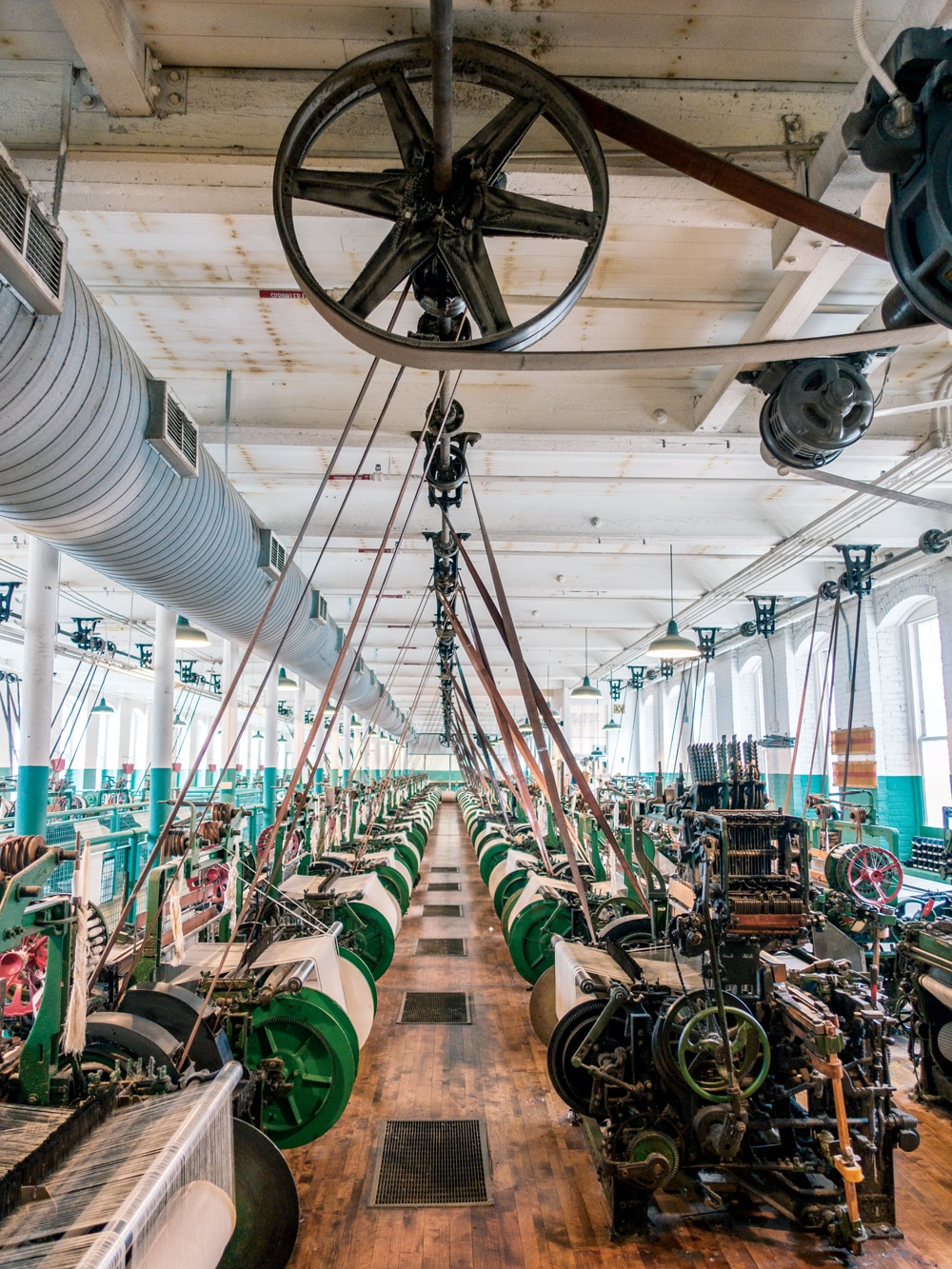Boott Cotton Mills Museum | Local Treasure
Though New England’s textile boom is long past, its echoes still rumble through Lowell National Historical Park.

The Boott Cotton Mills Museum’s weave room, with its dozens of working looms. Built in the 1830s, the Boott mill complex is today home to offices and condos as well as this namesake museum.
Photo Credit : Michelle Aldredge
Photo Credit : Michelle Aldredge
Even with just a couple of looms operating, the noise is already overpowering. Standing in the weave room of the Boott Cotton Mills Museum in downtown Lowell, Massachusetts, surrounded by dozens more looms that aren’t yet running, I can only imagine the din of days gone by.
As pulleys and poles spin overhead, the looms—once hydro-powered, now motorized—get up to speed. What started as a wall of sound morphs into a steady throb that can be felt as much as heard, the way the drums of a passing marching band can seem to momentarily co-opt one’s heartbeat.
In the Boott mills’ mid-19th-century heyday, hundreds of workers walked these floors. Today, two lone staffers are at the controls, demonstrating the looms for visitors and weaving fabric to be sold in the museum gift shop. Mike Auger is a relative newcomer at Boott, but he has a veteran’s familiarity with the machines, having operated similar ones at a fiberglass mill in nearby Haverhill in the 1980s. With him is John O’Keefe, who has worked here for more than two decades. They move steadily from machine to machine, making adjustments and answering questions.
These looms are not original to the Boott mills, which were cleared out long ago. Salvaged from a Midwestern mill, they were made by the Draper Corporation of Hope-dale, Massachusetts, once the largest manufacturer of power looms in the nation.
With its location on the Merrimack River, Lowell was a planned industrial city, inspired by the factory towns of Europe. The steady employment—as hard as it was—offered by its water-powered textile mills had tremendous appeal to a workforce made up primarily of recent immigrants and young men and women from nearby farms.
A staircase at the far end of the weave room leads to upstairs displays that chronicle the rise and decline of the Boott mills as well as the industrial economy of Lowell in general. There is no sugarcoating of history here, a fact accentuated by video clips in which workers talk about the harsh realities of mill life.
One story that stuck with me was that of a young boy whose family worked in the Lowell mills in the 1940s. Each day he left school at lunchtime, walked home, and made lunches for his mother, father, and godfather. He brought one lunch to the mill where his mother worked, then walked to the mill where his father and godfather worked. After delivering their lunches, he collected money from other workers to buy food for them. By the time he came back from that errand, his father and godfather were done eating. He collected their leftovers, went back to the other mill to collect his mother’s leftovers, then walked home, ate his own lunch, and finally returned to school. All this, because the mills were so badly infested with cockroaches that the workers could not bring a lunch and protect it while at their machines.
At the heart of the Boott mill complex is a courtyard, with a clock tower whose steel bell would chime six times a day, serving as the mill’s time clock. Workers arriving after the morning bell would find the gates locked and be forced to enter through the adjacent counting house, where the mill agent held the power to dock their pay or dismiss them outright.
Though Lowell’s textile boom lasted for more than a century, the industry here and throughout New England experienced a sharp decline after World War II. Boott Cotton Mills closed its doors in 1955; by the 1960s, many of Lowell’s mill buildings were abandoned.
But in 1978, thanks in part to the support of Lowell native Paul Tsongas, then a U.S. representative, the Lowell National Historical Park was created, preserving a large swath of industrial infrastructure downtown. The park encompasses not only the Boott mills but also the Pawtucket Dam and Gatehouse, the Suffolk Mill Turbine and Powerhouse, the Kirk Street Agents House, the Mill Girls and Immigrants Boardinghouse, and the Lowell Canal System. There’s the Patrick J. Mogan Cultural Center, which focuses on the lives of Lowell’s many generations of immigrants, and tours on working streetcars and, in warmer months, canal tours conducted by boat.
Before leaving, I make another pass through the weave room, where Auger and O’Keefe are running the machines for a group of school kids. Still feeling the throb of the looms as I exit, I think of a memory O’Keefe shared from his youth, one of walking the streets of Lowell just after World War II and hearing the thrum of the mills. It was everywhere back then—the sound of the city, the literal pulse of Lowell.
115 John St., Lowell, MA. 978-970-5000; nps.gov/lowe
Joe Bills
Associate Editor Joe Bills is Yankee’s fact-checker, query reader and the writer of several recurring departments. When he is not at Yankee, he is the co-owner of Escape Hatch Books in Jaffrey, NH.
More by Joe Bills

